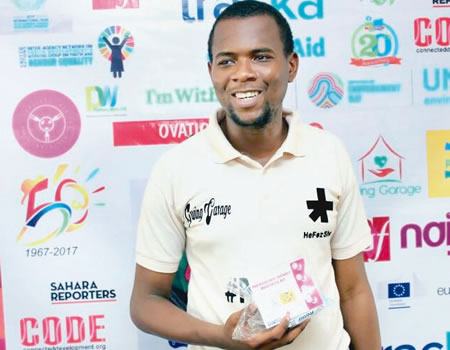They call you the Pad Man, why is that?
The man who loves giving pad was born out of the story of the Menstruation Man in India. PadMan is an initiative getting men to be deliberately involved in issues of humanity. PadMan is adopting the United Nations’ #HeForShe model to encourage men to play a role in soliciting for adequate funding and awareness for girl/women causes. PadMan promotes loudly and unashamedly the role of good menstrual hygiene management in secondary schools as a trigger for better, stronger development of schoolgirls.
What prompted you to start the Pad Man Initiative?
Millions of impoverished girls face days with no access to safe feminine hygiene solutions. Girls turn to unsanitary methods of feminine hygiene including leaves, bark, newspapers, tissue paper, and in some cases, allow themselves to be exploited out of desperation for supplies.
What is goal with this initiative?
To educate 232,000 school girls in public schools in Nigeria and Ghana on Menstrual Hygiene Management (MHM) and reproductive health by the 2020. P roviding affordable and hygienic sanitary materials and disposal options to manage menstruation periods in effective, comfortable and hygienic ways. To also discourage the growth of gender inequality among young schools’ boys.
Is it sustainable?
The plan to sustain this initiative is by making these eco-friendly pads available in two product models: one, for retail consumption. This will come in a single pack of five pads and will be distributed using an online and SMS based distribution matrix. With the development of this online and SMS based matrix, PadMan will be able to scale a faster its distribution of this product to low income communities across Nigeria. Revenue from retail sales will also go back into providing as many schoolgirls with menstrual kit and MHM education
Two, as CSR product. This is not for sale and only for distribution only to schools and as relief materials. This pack will come with a pack of six pads for junior secondary students and pack of three for senior students, soap, wash cloth and MHM education infographics manual translated to local language of recipient community. This CSR product will be adopted by corporate organisations to support social causes for low income girls and women in Nigeria. The corporate organisation brand will be borne on the product packaging and on manual alongside global affiliations to the Sustainable Development Goals.
How do you get funding/support for the initiative?
Through crowdfunding, event sponsorship, philanthropy, sales of our products and new media services.
Would you consider yourself a social entrepreneur?
Social entrepreneurs are primarily motivated by an ethical imperative. They seek to respond to urgent needs. The question of why is paramount. Social entrepreneurs are primarily motivated by an ethical imperative. They seek to respond to urgent needs. The question of why is paramount and if I do consider myself as a social entrepreneur. I am a LEAP Africa Social Innovators Programme Fellow, we build on making more impact and we provide products that can offer both worlds with our tagline – More Impact and More Money.
In 2011, you founded a social enterprise called Giving Garage. Tell me about your progress in the last three years or so.
My most important innovation is Giving Garage and the lessons learned were hard work and that being consistent pays a lot.
Save Pwashikai Nideno campaign which we achieved in 2012 attracted so much media buzz and funds donated led to the successful vaginoplasty. In 2013, I was nominated as a Universal Peace Federation Ambassador of Peace and in 2014, I was nominated as A World at School Global Youth Ambassador. Giving Garage metamorphosed from Charity Lounge as an ambitious non-profit platform, servicing as a solution space to assist social innovators, we add the fun-in-fundraising at our events and in bringing together mentors to their mentees, to empower them to be great leaders and as sustainable social change agent. We also serve as a platform to reaching out to the under privileges in the society, by creating avenues for the promotion of charity using technology and adopting social media for social good.
The Giving Garage Project was showcased at the Third UN World Conference on Disaster Risk & Reduction in Sendai-Japan as a Youth Friendly Environmental Space in its Pilot Stage and as a case example at Shared Value Initiatives conference in New York in May 2015.
Giving Garage also won the best idea produced –campaign in the 2015 Summit Creative Award competition with more than 5000 submissions from 23 countries hosted by the Summit International Awards.
Tell me about your failures and what you learned from them.
When I was first starting out in the industry, I failed at communicating with a client. This led to a loss of revenue for the department. When I realised what I had done, or rather what I had failed to do, I immediately took responsibility for my inactions. I went to the client and talked with them. It took a while, but I finally got it all back on track. Since then, I have made sure to attend seminars and workshops to help me avoid the same type of failures.
I have also learned to share my pains in the open, even if it brings me shame or some forms of commendation, I had failed in not asking in the past, and had cause to explain severally to people this are for public spirited, we don’t hide the mentions of our wins, donations or success. It’s not priding like my friends would claimed if it’s for a good cause.
In what specific ways can Nigerian entrepreneurs help achieve the United Nations Sustainable Development Goals?
In a constantly fast-changing world, organizations focusing on social impact have no other choice than to re-invent themselves. In fact, as the demand for solutions toward reducing inequalities, diminishing poverty and fostering community spirit grows, the means at our disposal to address such issues decrease. Therefore, it is essential to think about new and innovative economic models. Social entrepreneurship presents an extraordinary opportunity to develop cost effectiveness and high impact as pillars for sustainable development. Such hybrid models combine philanthropy, subsidies, and income generating activities to generate varying degree of income (depending on the maturity of the project, its sector of activity, and so on.). New drivers of growth and development lie in new forms of “win-win-win” collaboration with other actors, such as the private sector or government. Thus, there are tremendous opportunities for organizations interested in new forms of entrepreneurship changing the world to reinvent themselves.
How does someone who studied Computer Engineering move into Social Entrepreneurship space? What’s the motivating factor?
I am motivated by meeting set targets within deadlines, as it gives me a sense of accomplishment and it’s something that I can look back on and say “I achieved that”.
I’m also motivated by visible results – for example, as a Computer Engineering Student at Olabisi Onabanjo University. I got a sense of accomplishment from knowing that working with student on humanitarian activities as a member of both Rotary and Lion International at the same time – I used to be addressed as Rotaractor Leo Chaste so I also applied my knowledge of computer engineering usng social media for social good.
You juggle a lot. Your LinkedIn profile says you’re Chief Product Officer at Giving Garage, a Founder at Brown Heart Foundation and an Executor of WorldMerit360 Action Plan 003 for SDG5. So, do you not suffer burn out?
I wore my workaholism like a badge of honour. The way I saw it, I had an awesome job and would work as hard as it took to do well. All this positions are related: Brown Heart metamorphosed to Giving Garage, I’ll earn my spot at the table with my impressive work ethic with this portfolio, as an errand-master of all with a servant leadership.






